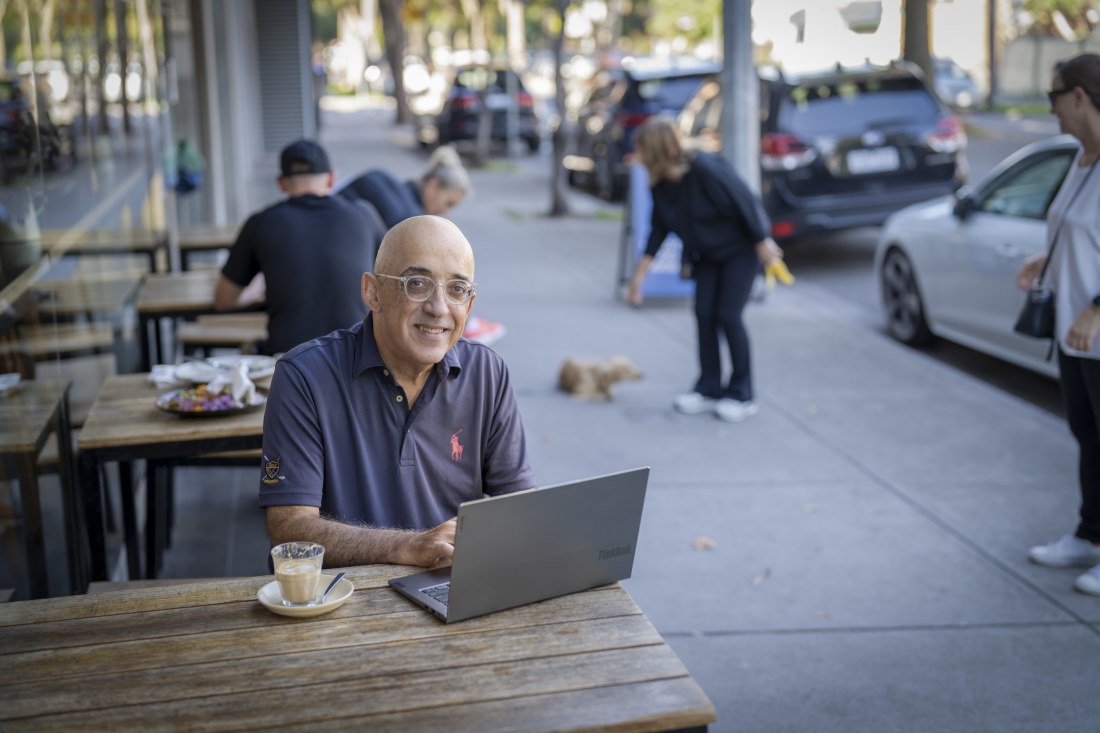Why more Australians are choosing semi-retirement
For former chief executive George Bisas, tackling retirement cold turkey was never an option. “I was a little fearful of going from a very busy day to having nothing to do,” he says.
So when he stepped down from the top job at interpreting and translation business Language Loop in mid-2023, he chose semi-retirement, transitioning into a consulting role with the company for several months before stepping away.
Almost a year on, work for Bisas, 65, consists of a combination of consultancy and directorships, which take up about 10 to 15 hours a week. He spends the rest of his time pursuing hobbies and interests such as writing short stories, keeping fit and travelling, and will soon tackle learning Indonesian language.

Former CEO George Bisas is semi-retired and likes travelling and writing short stories. Eamon Gallagher
Bisas says he began planning his transition to retirement in his early 60s. This involved a consideration of how he would fill his days, along with how he would replace his full-time income. But despite his planned approach, the transition wasn’t easy, he says, citing a loss of status and a lack of daily structure among the biggest challenges.
“When you’re working, your life has really set structure to it,” Bisas says. “You’ve got an identity, you have relationships with people on a full-time basis. There’s a real sense of purpose and, in my roles, there was a sense of power as well given they were senior executive roles.”
A growing trend
Since the pandemic, the expected retirement age of Australians has increased, driven by a lift in those entering part-time employment, analysis from KPMG has found.
“The adoption of working from home has made many older Australians in professional jobs realise that they could ‘semi-retire’ and continue to dabble in the workforce from home or even from a coastal location,” says KPMG urban economist Terry Rawnsley.
Rawnsley says a two- or three-year period of semi-retirement is becoming the norm for a fortunate group of people whose health and financial status gives them flexibility.
Hitting 65 is no longer about working five days a week then saying “see you later”, Rawnsley says. It’s about stepping down to four, then three and then maybe two days a week.
Last year, the expected retirement age from full-time work was 63 for men and 62 for women, up two years for men and three years for women compared with 20 years ago.

More than two-thirds of Australians plan to continue working in some form past the current retirement age of 67, the 2024 Colonial First State Rethinking Retirement report found.
Most want to reduce their working hours but continue in the same role, while others plan to pursue a passion project working fewer hours, dip in and out of work or switch to a less demanding role.
Most over-65s also believe they should be able to continue working for as long as they want to and just 7 per cent believe they have an obligation to step back from work at 67 to make way for younger workers.
Planning is key
Sandy Hutchison, a former corporate HR director and founder of career transition consultancy Career Money Life, says many people experience a rocky start to retirement.
“Really competent, successful people can lose their confidence during this phase because they have so much identity attached to what’s on the business card,” she says.
It’s one reason she’s an advocate of using semi-retirement as a stepping stone to full retirement. “We always recommend that if people can, they make that step either with their existing employer or moving into consulting or contracting or setting up their own small business that they do on a part-time basis.”
She says this gives people a balance between still being connected to the workforce, but having the time to start exploring hobbies and interests “so they can start to build that new world gradually”.
“Often for people it can be the first time in their life where they’ve really had an opportunity to deliberately choose how they spend their time.”

Sandy Hutchison says planning is essential to a successful move to semi-retirement.
Hutchison says people who do a “hard stop” usually find the transition more difficult, especially if they don’t have a social infrastructure outside of work. She says another key to a successful transition is embedding a routine.
“A lack of structure, particularly if people have been used to a full diary, can be pretty overwhelming. It doesn’t need to be quite as full on as full-time work but having things to look forward to, having things planned, is really important.”
Bisas says when he first moved to semi-retirement he felt “like I was on a permanent vacation, and it wasn’t great for me, I was floundering”.
His daily routine now includes up to 90 minutes of exercise first thing, followed by paid work, then writing and catching up with friends.
Though there is no magic age people should begin the planning process, Hutchison suggests that as workers enter their 50s, retirement should be on their radar – and not just the financial considerations.
“What they focus on and think about is the financial piece, but what they haven’t done is actually thought: ‘How am I going to fill my day?’ If you have a mental awareness of it, then you might start to notice opportunities or things that interest you.”
Of course, the financial realities of retiring are a vital consideration.
The financial question
One of the key issues that weighs on the minds of pre-retirees is how much money they’ll need in retirement. Testing the waters via semi-retirement gives them the option to scale up their work commitments again should they find they’re coming up short.
Kieran Liston, the founder of accountancy and financial advice practice Liston Newton Advisory, is himself semi-retired, working 2½ days a week as a director and consultant at the firm. He says that when considering a move into semi-retirement, it’s important that people do not underestimate their living expenses because they rarely want to compromise on the lifestyle they’ve become accustomed to. “I tell them to work out what their living expenses are and to assume that they’re going to stay exactly the same,” he says.
At 73, Liston is enjoying a combination of paid and unpaid work. He and his wife moved from Melbourne to the seaside town of Torquay eight years ago, and each day now starts with an ocean swim, a walk with the dog and coffee with friends. The rest of his non-work days are taken up with volunteering.
Liston says people who have run their own business often find it more difficult to retire than salaried employees. “The business is often their reason for being and when it’s gone, even partially, they find themselves lost,” he says.
“I have many instances where clients have sold their business hoping to stay on only to find that the new owner doesn’t really want them or they can’t work with the new owner. To make matters worse, some then go out and buy a new business in an industry they know nothing about and lose all the money they made from the sale of the old business – a disaster.”
Again, planning is key.
James McFall, the founder and managing director of Yield Financial Planners, agrees the starting point should be a clear idea of how much income you think you will need each year.

James McFall, founder and managing director of Yield Financial Planners says many people fear running out of money in retirement.
Working that out can be trickier than it sounds, and a fear of falling short means “the vast majority of our clients end up working longer than they need to because they’ve already achieved what they need financially to retire securely”, he says.
“First, quantify what you need, and then what you want,” McFall says.
“That way you can be sure your needs will always be met, like food on the table and electricity, and you will understand what it costs. By separately quantifying what you want in life, you can determine if it is affordable, and if not, you can compromise as required to achieve what is most important to you.”
Bisas started planning for his semi-retirement several years in advance with his financial adviser. Despite having an “extremely solid” financial position, running out of money “always remains a bit of a concern”, especially in the face of the rising cost of living.
Once McFall thinks a client has reached a position where they can afford to retire, he lets them know and initiates a conversation about the structure of their financial affairs.
“There are various ways people can structure their finances to enable them to move into semi-retirement, including downsizing or selling assets to release equity, and then utilising suitable tax structures like superannuation, trusts and companies or simply investing in your personal names, to maximise your after-tax outcomes,” he says.
Transition to retirement option
Rules limit the age at which someone can draw down on their super in its entirety, and it is necessary to be officially retired to do so. Accessing some super as a regular income stream through a transition to retirement (TTR) pension is an option for many semi-retirees, but not something Liston is a huge fan of if they have other ways to replace the lost income. “The longer you can continue to grow your super, the better off you’re going to be,” he says.
To start a TTR, semi-retirees must have reached their preservation age of between 55 and 60 (dependent on their year of birth) while the payments are tax-free for those over 60.
The benefit of leaving super untouched is that it can continue to grow until full retirement.
Semi-retirees will continue to get super contributions from their employer for as long as they are employed, and can continue to make voluntary contributions until 75 providing their super balance is below $1.9 million and they don’t exceed contribution caps.
Those aged 67-75 need to work for a total of at least 40 hours in a consecutive 30-day period to claim a tax deduction on any personal super contributions they make.
McFall also advises clients contemplating semi-retirement to consider their investment risk appetite.
“Normally it is appropriate to reduce risk at this stage, as you move from an accumulation stage of your life, to placing more emphasis on preserving the capital you have worked hard to build,” he says.
“It is a balance, though, as you need to keep part of your portfolio invested for growth in shares and property, to increase longevity of your funds. You also need sufficient liquidity to meet income and lump sum expenses while keeping an eye on sequencing risk, which is the risk of being forced to sell growth assets while markets are down.”
Subscribe to gift this article
Gift 5 articles to anyone you choose each month when you subscribe.
Subscribe nowAlready a subscriber?
Introducing your Newsfeed
Follow the topics, people and companies that matter to you.
Find out moreRead More

Latest In Personal finance
Fetching latest articles